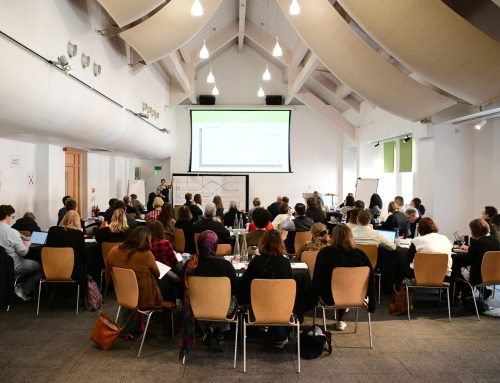Building on from the backdrop of a renewed interest in the civic role that universities play in their local areas, members of the National Civic Impact Accelerator (NCIA) team co-led a special session at the 2025 Regional Studies Association conference, Porto, Portugal, on Strategies for Universities' Civic Responsibilities and Community Impact. The session outlined the context for the civic role of universities, before exploring real-life examples. Three of these examples are covered in the Bringing Together Civic Practice section, while the remaining three are discussed in the Challenges and Solutions section.
Civic flashes
Advancing good practice in civic activities within universities is not new. Groups such as Campus Compact and MetroLab networks in the USA, along with the global Talloires Network of engaged universities, have been building strong communities of practice around the civic roles of universities for several decades.
The UK is no exception. In fact, in 2009, John Goddard called for renewed interest in the role of the original civic universities (such as Manchester, Birmingham or Newcastle) in the Nesta publication Re-inventing the civic university. The early 2020s have seen a further revival of this focus, with the work of the Civic University Commission, the creation of the Civic University Network, and the NCIA project all serving as recent examples.
In November 2024, the UK Secretary of State for Education, Bridget Phillipson, wrote to university vice-chancellors in England calling for them to, "Play a greater civic role in their communities" as part of the Labour government's tuition fee increase.

A sunset view of Porto, Portugal, featuring the iconic Dom Luís I Bridge – Photo by Everaldo Coelho on Unsplash
Regional studies and civic universities
We shouldn't be surprised, then, that the civic role of universities is receiving attention in academic and practitioner communities such as the Regional Studies Association. The regional role of universities often has many civic dimensions, just as the civic role frequently has regional ones. Indeed, some sessions at the conference used the terms interchangeably when discussing the responsibilities and actions universities take in response to their localities.
So, what did the NCIA session cover that could help to ensure this renewed civic focus is more than just another flash in a pan?
Bringing together civic practice
Learning from the leading edge
The first part of the RSA special session, led by Johannes Read and Des McNulty, presented research findings on good practice from the leading edge of civic university work in the UK, North America and Europe. It outlined three different drivers of civic work:
- Universities – e.g. civic university agreements in the UK that outline how universities will work in partnership with local communities.
- Funders – e.g. Department for Innovation Systems in Sweden funding the Forum for Social Innovation, supporting the co-created research collaborations in six areas across Sweden.
- Local authorities – e.g. Boston Area Research Initiative (BARI) in Boston, Massachusetts, USA, where the City of Boston formalises the relationships between universities, researchers, policymakers, practitioners and civic leaders.
Embedding civic work day-to-day
Civic work is not a one-off activity. It is a practice developed over time and embedded in the day-to-day teaching and research activities of universities.
In terms of teaching, Julian Paenke and Lloyd Jenkins from the University of Birmingham outline the benefits of student-stakeholder civic education practice via the Year in Civic Leadership programme. This brings civic work alongside the more well-established options of a year abroad or in industry.
Regarding research, Sara Hassan outlined the role of universities in developing and supporting community researchers through the Liveable Neighbourhoods project in Tyseley and Hay Mills in Birmingham, and efforts to address mental health in Gaza with the Palestine Trauma Centre. These initiatives train community members to take active roles as co-researchers, integrating lived experiences and build community capacity.
Challenges and solutions?
Original Civic Universities need to become 'Truly Civic'
John Goddard, Des McNulty and John McWilliams' presentation reflected on the role that universities play in societal infrastructure and place-based redevelopments. They argued that the original civic universities still have progress to make before they can claim to be "truly civic". However, they pointed to the work of the Helix in Newcastle as a promising shift in approach. It is based on collaboration between academia, business, local government and civic society to create positive change for the city. The Helix, based around a major regeneration site in central Newcastle, is a promising change in approach. The aim is "to make the site the focus and engine room for innovation-driven growth in the region helping shape the University's strategic thinking, alongside the City Council's Inclusive Economic Growth Strategy and a commercial office developer's Inclusive Capitalism agenda".
The protagonists suggest that The Helix could become the hub for a partnership between business, academic and research institutions, the public sector and local community. But they recognise that this will require a change of mindsets that may be at odds with previously prevailing attitudes and practices. This will require revised incentives for all if the future vision for approaches is to be realised.

Porto, Portugal – Photo by Nick Karvounis on Unsplash
The role of leadership
Leadership is both part of the challenge and the solution. Matthew Guest shared early findings from his PhD research on how field theory can help to develop understandings of civic leadership within universities. University leaders often operate not only within the field of higher education but also across local authority, business, and civil society. They have to combine local, regional, national and international responsibilities, for example, seeking global standing and contributing to local urban regeneration. The development of capacity to understand, reflect on and navigate these domains and potential tensions between them is key to the development of civic leadership.
Learning from anti-racism
While these ideas sound promising, how might they be realised in practice? One successful model of institutional change comes from anti-racist work. Femi Owolade shared reflections on the importance of allies working with activists in universities to embed anti-racist actions. Civic engagement professionals could adopt a similar strategy-building alliances with senior leaders and long-serving staff to advocate for civic work. Developing trusted relationships and telling powerful stories are important for this. To do this, universities need to embed equity, and embrace co-production.
More than a flash in the pan
Arguably, the civic role of universities is more important than ever. The coincidence of multiple crises across the world has far reaching implications for universities and cannot be ignored. The NCIA session and wider RSA conference showed the relevance of regional research, teaching and engagement activities carried out by those universities that are embedded within their towns, cities and regions.
Policy makers and institutional leaders across the world have to recognise that the current financial crises facing universities is just an outward and visible sign of a deeper threat affecting the institutions. We need to make sure that this current focus is not just a flash of interest but that it translates into longer-term, sustainable actions.
Our message is that government support for the civic role of universities is not only for our benefit but for society at large as we seek to address multiple global crises through local actions.
The co-authors of the blog and presenters at the special session Johannes Read, Matthew Guest, John Goddard and Femi Owolade would like to thank Sara Hassan for co-leading the special session, and Des McNulty, John McWilliams and Julian Paenke for their presentations and contributions.
Building on from the backdrop of a renewed interest in the civic role that universities play in their local areas, members of the National Civic Impact Accelerator (NCIA) team co-led a special session at the 2025 Regional Studies Association conference, Porto, Portugal, on Strategies for Universities' Civic Responsibilities and Community Impact. The session outlined the context for the civic role of universities, before exploring real-life examples. Three of these examples are covered in the Bringing Together Civic Practice section, while the remaining three are discussed in the Challenges and Solutions section.
Civic flashes
Advancing good practice in civic activities within universities is not new. Groups such as Campus Compact and MetroLab networks in the USA, along with the global Talloires Network of engaged universities, have been building strong communities of practice around the civic roles of universities for several decades.
The UK is no exception. In fact, in 2009, John Goddard called for renewed interest in the role of the original civic universities (such as Manchester, Birmingham or Newcastle) in the Nesta publication Re-inventing the civic university. The early 2020s have seen a further revival of this focus, with the work of the Civic University Commission, the creation of the Civic University Network, and the NCIA project all serving as recent examples.
In November 2024, the UK Secretary of State for Education, Bridget Phillipson, wrote to university vice-chancellors in England calling for them to, "Play a greater civic role in their communities" as part of the Labour government's tuition fee increase.

A sunset view of Porto, Portugal, featuring the iconic Dom Luís I Bridge – Photo by Everaldo Coelho on Unsplash
Regional studies and civic universities
We shouldn't be surprised, then, that the civic role of universities is receiving attention in academic and practitioner communities such as the Regional Studies Association. The regional role of universities often has many civic dimensions, just as the civic role frequently has regional ones. Indeed, some sessions at the conference used the terms interchangeably when discussing the responsibilities and actions universities take in response to their localities.
So, what did the NCIA session cover that could help to ensure this renewed civic focus is more than just another flash in a pan?
Bringing together civic practice
Learning from the leading edge
The first part of the RSA special session, led by Johannes Read and Des McNulty, presented research findings on good practice from the leading edge of civic university work in the UK, North America and Europe. It outlined three different drivers of civic work:
- Universities – e.g. civic university agreements in the UK that outline how universities will work in partnership with local communities.
- Funders – e.g. Department for Innovation Systems in Sweden funding the Forum for Social Innovation, supporting the co-created research collaborations in six areas across Sweden.
- Local authorities – e.g. Boston Area Research Initiative (BARI) in Boston, Massachusetts, USA, where the City of Boston formalises the relationships between universities, researchers, policymakers, practitioners and civic leaders.
Embedding civic work day-to-day
Civic work is not a one-off activity. It is a practice developed over time and embedded in the day-to-day teaching and research activities of universities.
In terms of teaching, Julian Paenke and Lloyd Jenkins from the University of Birmingham outline the benefits of student-stakeholder civic education practice via the Year in Civic Leadership programme. This brings civic work alongside the more well-established options of a year abroad or in industry.
Regarding research, Sara Hassan outlined the role of universities in developing and supporting community researchers through the Liveable Neighbourhoods project in Tyseley and Hay Mills in Birmingham, and efforts to address mental health in Gaza with the Palestine Trauma Centre. These initiatives train community members to take active roles as co-researchers, integrating lived experiences and build community capacity.
Challenges and solutions?
Original Civic Universities need to become 'Truly Civic'
John Goddard, Des McNulty and John McWilliams' presentation reflected on the role that universities play in societal infrastructure and place-based redevelopments. They argued that the original civic universities still have progress to make before they can claim to be "truly civic". However, they pointed to the work of the Helix in Newcastle as a promising shift in approach. It is based on collaboration between academia, business, local government and civic society to create positive change for the city. The Helix, based around a major regeneration site in central Newcastle, is a promising change in approach. The aim is "to make the site the focus and engine room for innovation-driven growth in the region helping shape the University's strategic thinking, alongside the City Council's Inclusive Economic Growth Strategy and a commercial office developer's Inclusive Capitalism agenda".
The protagonists suggest that The Helix could become the hub for a partnership between business, academic and research institutions, the public sector and local community. But they recognise that this will require a change of mindsets that may be at odds with previously prevailing attitudes and practices. This will require revised incentives for all if the future vision for approaches is to be realised.

Porto, Portugal – Photo by Nick Karvounis on Unsplash
The role of leadership
Leadership is both part of the challenge and the solution. Matthew Guest shared early findings from his PhD research on how field theory can help to develop understandings of civic leadership within universities. University leaders often operate not only within the field of higher education but also across local authority, business, and civil society. They have to combine local, regional, national and international responsibilities, for example, seeking global standing and contributing to local urban regeneration. The development of capacity to understand, reflect on and navigate these domains and potential tensions between them is key to the development of civic leadership.
Learning from anti-racism
While these ideas sound promising, how might they be realised in practice? One successful model of institutional change comes from anti-racist work. Femi Owolade shared reflections on the importance of allies working with activists in universities to embed anti-racist actions. Civic engagement professionals could adopt a similar strategy-building alliances with senior leaders and long-serving staff to advocate for civic work. Developing trusted relationships and telling powerful stories are important for this. To do this, universities need to embed equity, and embrace co-production.
More than a flash in the pan
Arguably, the civic role of universities is more important than ever. The coincidence of multiple crises across the world has far reaching implications for universities and cannot be ignored. The NCIA session and wider RSA conference showed the relevance of regional research, teaching and engagement activities carried out by those universities that are embedded within their towns, cities and regions.
Policy makers and institutional leaders across the world have to recognise that the current financial crises facing universities is just an outward and visible sign of a deeper threat affecting the institutions. We need to make sure that this current focus is not just a flash of interest but that it translates into longer-term, sustainable actions.
Our message is that government support for the civic role of universities is not only for our benefit but for society at large as we seek to address multiple global crises through local actions.
The co-authors of the blog and presenters at the special session Johannes Read, Matthew Guest, John Goddard and Femi Owolade would like to thank Sara Hassan for co-leading the special session, and Des McNulty, John McWilliams and Julian Paenke for their presentations and contributions.







